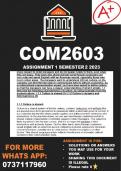, SECTION 1 INTERCULTURAL COMMUNICATION QUESTION 1 Read the scenario
below and answer the questions that follow. Managers at Z&B, a United States (US)
multinational coffee shop in Kenya, are trying to understand the culture of their
employees and customers on the African continent. They have noted that, unlike
their US customers, Kenyan customers show respect to older managers and do not
speak rudely to them, even when they are angry. They have also observed that
some Kenyan customers are very rude and speak English with an American accent,
especially those who live in urban areas. The managers want to understand African
culture, so the company can find the best way to communicate with its African
customers. As an intercultural communication expert, you have been asked to
define culture, so that the managers can have a deeper understanding of what it
entails. 1.1 Describe the following characteristics of culture, by using examples
from the scenario above. 1.1.1 Culture is shared (5) 1.1.2 Culture is dynamic and
heterogeneous (5)
1.1.1 Culture is shared:
Culture is a shared system of beliefs, values, customs, behaviors, and artifacts that are
passed down from generation to generation within a particular group or society. It is a
collective identity that binds people together and influences their worldview and
interactions. In the scenario above, we can see how Kenyan customers exhibit a shared
cultural characteristic of showing respect to older managers. This respect is likely
ingrained in the Kenyan culture, and it is an expected behavior in their interactions with
authority figures. On the other hand, some Kenyan customers speak English with an
American accent, indicating a shared exposure to American cultural influences, possibly
due to urbanization, media consumption, or other factors. This shared language pattern
reflects the influence of a broader cultural context on their communication style.
1.1.2 Culture is dynamic and heterogeneous:
Culture is not static; it evolves and changes over time due to various factors such as
globalization, migration, technological advancements, and intercultural interactions. In the
context of the scenario, we can observe the dynamic nature of culture in Kenya. While
some customers exhibit traditional values of respect towards authority figures, others may
display a more assertive and rude communication style, influenced by modern urban
lifestyles or exposure to different cultures. The coexistence of these different
communication styles within the same Kenyan society showcases the heterogeneous
nature of culture. Each individual or group may hold unique beliefs and practices,
contributing to the diversity within the broader cultural context of Kenya. As a result,
understanding African culture requires acknowledging and adapting to its dynamic and
multifaceted nature to effectively communicate with customers from various backgrounds.
QUESTION 2 According to Martin et al. (2013), there are four stages that minority
and majority identities go through, in their identity development. 2.1 Discuss the
following phases in minority identity development, and provide examples from your




